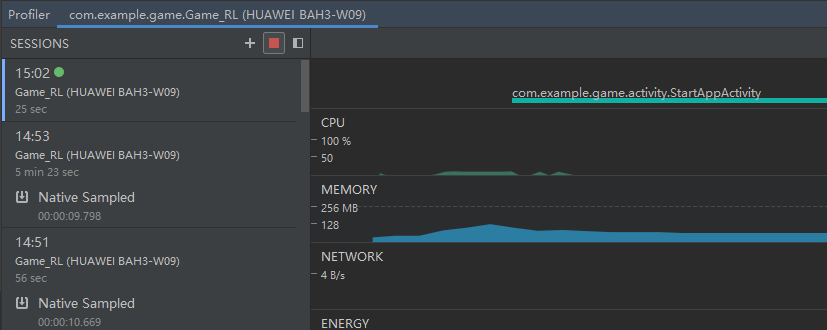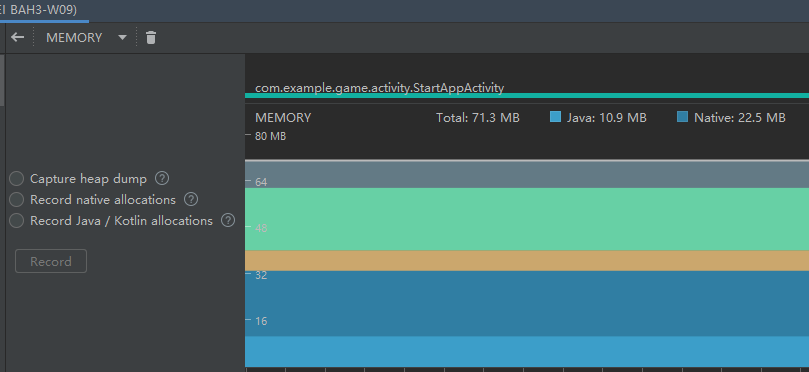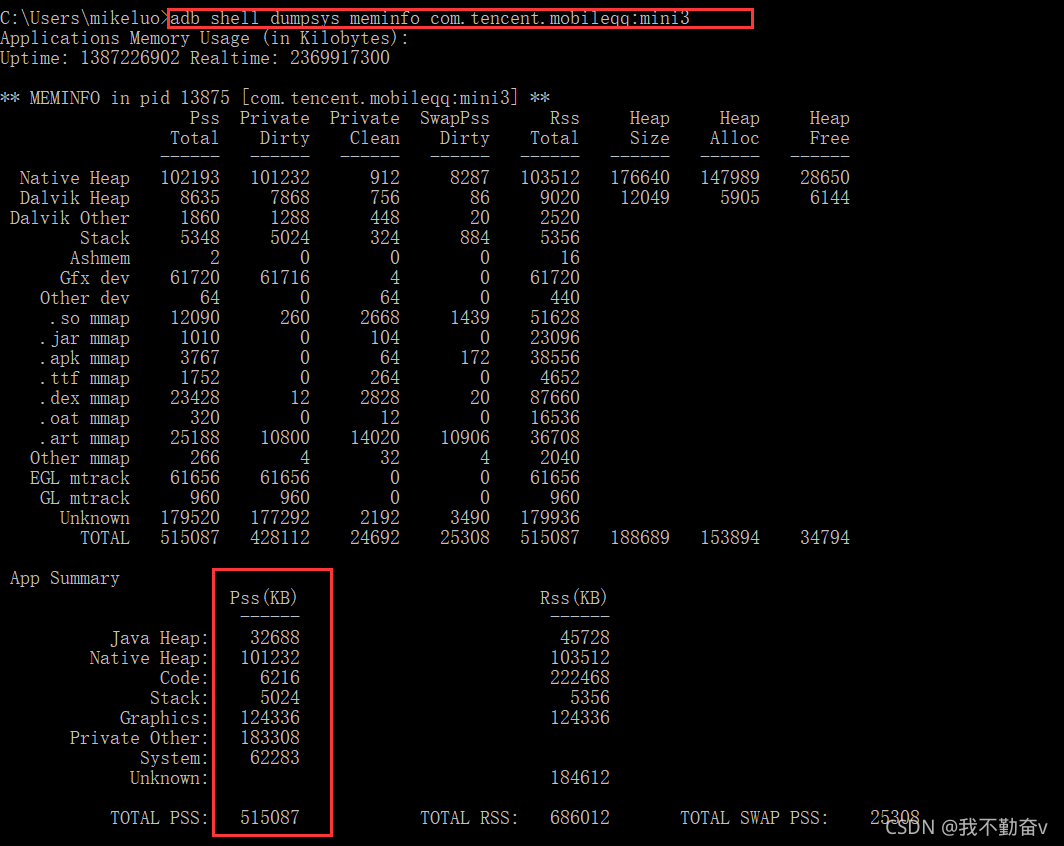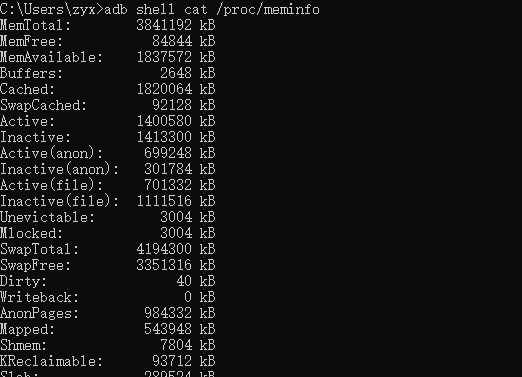Powered by Android Stuiod Profiler
Profiler usage:
Reference: https://blog.csdn.net/Calvin_zhou/article/details/119681272
Select View > Tool Windows > Profiler or click the Profile icon in the toolbar

TAP ANYWHERE ON THE MEMORY TIMELINE TO OPEN THE MEMORY PROFILER
 Memory Classification:
Memory Classification: Java: The memory of an object allocated from Java or Kotlin code
Native: The memory of an object allocated from C or C++ code
Graphics: The graphics buffer queue is the memory used to display pixels to the screen, including GL surfaces, GL textures, and so on
Stack: The memory used by the native and Java stacks in your app. This is usually related to how many threads your app runs
Code: Your app is used to process code and resources (such as dex bytecode, optimized or compiled dex code, . so libraries and fonts).
Others: The system used by your app is not sure how to classify memory
Allocated: The number of Java/Kotlin objects assigned by your app. This number does not count towards objects assigned in C or C++
Get the actual memory usage of the application
https://zhuanlan.zhihu.com/p/372883142
Generally, PSS is used as a memory performance indicator, use method 3
VSS - Virtual Set Size (including memory occupied by shared libraries)
RSS - Resident Set Size Actual use of physical memory (including memory occupied by shared libraries)
PSS - Proportional Set Size Actual physical memory used (proportional allocation of memory occupied by shared libraries) If 3 processes use the same shared library, then the PSS of each process includes 1/3 of the size of the shared library memory. Usually we use PSS size as a memory performance metric.USS - Physical memory occupied by the Unique Set Size process alone (excluding memory occupied by shared libraries)
In general, the memory usage is as follows: VSS >= RSS >= PSS >= USS
Method 1 adb
- adb shell
- top
- Check the PID based on the package name
 1. adb shell dumpsys meminfo package name or process ID
1. adb shell dumpsys meminfo package name or process ID adb shell dumpsys meminfo com.tencent.mobileqq:mini3 1. If you want to see the memory cost of all processes of an app
1. If you want to see the memory cost of all processes of an app Use the command adb shell dumpsys meminfo | findstr package name (win10 cmd), as shown in the figure, you can know which processes QQ has and the memory occupation of the corresponding process.
 ## Method 2 pid status
## Method 2 pid status "/proc/" + android.os.Process.myPid() + "/status" path file.
public static long getProcessRealMemory() {
String memFilePath = "/proc/" + android.os.Process.myPid() + "/status";
BufferedReader bufferedReader = null;
try {
FileInputStream fileInputStream = new FileInputStream(memFilePath);
InputStreamReader inputStreamReader = new InputStreamReader(fileInputStream, "UTF-8");
bufferedReader = new BufferedReader(inputStreamReader);
String line;
while ((line = bufferedReader.readLine()) != null) {
Log.d(TAG, " read line : " + line);
if(! TextUtils.isEmpty(line) && line.contains("VmRSS")) {String rss = line.split(":")[1].trim().split( " ")[0];
return Integer.parseInt(rss) * 1024;
}
}
} catch (Exception e) {
e.printStackTrace();
} finally {
if(bufferedReader != null) {
try{
bufferedReader.close();
} catch (Exception e) {
e.printStackTrace();
}
}
}
return -1;
}Advantages: There is no permission restriction for the time being, and it can be obtained in real time
Disadvantages: The memory obtained by this method of reading files is RSS. What we usually expect is to get a PSS
Difference between RSS and PSS:
RSS - Resident Set Size Actual use of physical memory (including memory occupied by shared libraries)
PSS - Proportional Set Size Actual physical memory used (proportional allocation of memory occupied by shared libraries) If 3 processes use the same shared library, then the PSS of each process includes 1/3 of the size of the shared library memory. Usually we use PSS size as a memory performance metric.
Method 3 ActivityManager (PSS)
ActivityManager activityManager = (ActivityManager) getSystemService(Context.ACTIVITY_SERVICE);
final Debug.MemoryInfo[] memInfo = activityManager.getProcessMemoryInfo(new int[]{android.os.Process.myPid()});
final int totalPss = memInfo[0].getTotalPss();Pros: PSS is obtained
Disadvantages:Android P limits the frequency above,It takes about 5 minutes (different mobile phones have different intervals) to get the new value。 And the PSS you get doesn't include Graphics.
Method 4 Debug.getMemoryInfo
Debug.MemoryInfo memoryInfo = new Debug.MemoryInfo();
Debug.getMemoryInfo(memoryInfo);
if (Build.VERSION.SDK_INT >= Build.VERSION_CODES. M) {
String javaHeap = memoryInfo.getMemoryStat("summary.java-heap");
String nativeHeap = memoryInfo.getMemoryStat("summary.native-heap");String code = memoryInfo.getMemoryStat("summary.code");
String stack = memoryInfo.getMemoryStat("summary.stack");
String graphics = memoryInfo.getMemoryStat("summary.graphics");
String privateOther = memoryInfo.getMemoryStat("summary.private-other");
String system = memoryInfo.getMemoryStat("summary.system");
String swap = memoryInfo.getMemoryStat("summary.total-swap");
}Advantages: PSS is obtained, and there is no frequency limit, and the components of PSS can be obtained
Cons: The acquired PSS does not include Graphics. Android below 6 does not allow you to get the occupied memory of a component through the Debug.MemoryInfo.getmemoryStat interface, but only through the reflection method
Get the memory information of the phone
- View the memory usage information
Adb shell free

- View the memory usage details
Adb shell cat /proc/meminfo

